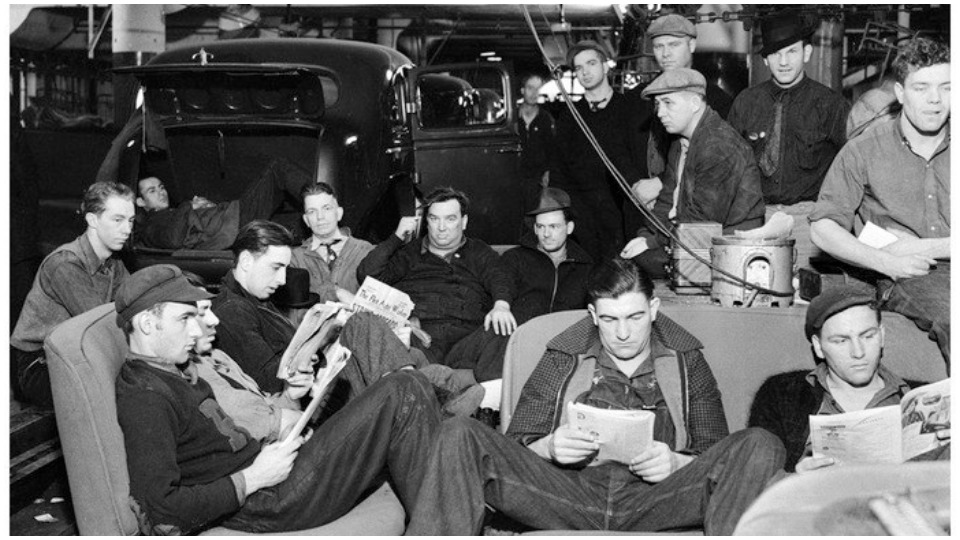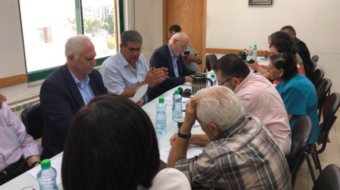
This is part two of a two-part article on the Communist Party USA in the 1930s. Part one can be read here.
The strikes of the early 1930s and New Deal legislation emboldened a group of unions led by John L. Lewis, head of the United Mine Workers Union, to call for a policy of organizing industrial unions at the American Federation of Labor’s 1935 convention. The AFL was still largely a body of “skilled workers,” rather than those who worked on assembly lines and in mass production. After the convention voted the organizing proposal down, Lewis and a number of unions walked out to form the Committee for Industrial Organization.
But who would organize new industrial unions? Although Lewis was an opponent of socialists and communists, he realized that without an alliance with Communist Party USA activists, the chances of forming industrial unions were slim. So he met privately with CPUSA General Secretary Earl Browder and came to an agreement. Experienced CPUSA organizers would represent the CIO as long as they did not use their positions to recruit members for the party.
Lewis wanted to build industrial unions as an end in itself. Communists saw industrial unions as part of a process that would empower working people and help them advance toward a socialist society. Of the first 200 CIO organizers, 50 were CPUSA activists. They were among the most successful in building the organizing committees into functioning trade unions, winning union elections and leading successful strikes. After attempts at reconciliation with the AFL failed, the CIO ceased to be a Committee and became the Congress of Industrial Organizations.
In the 1936 elections, President Franklin Roosevelt ran on the major labor and social welfare reforms his administration had enacted while his enemies denounced him as a “Communist dictator” destroying freedom and the “American way of life.” He hit back, denouncing them as “economic royalists” for whom freedom and democracy meant only the protection of their wealth and power.
While the Communist Party ran its own presidential ticket, with Earl Browder for president and James W. Ford for vice president, it also spent considerable effort to distinguish between Roosevelt, who had enacted major reforms in the interests of working people, and the Republican candidate Alf Landon, who pledged to repeal those reforms. The CPUSA saw a Landon victory as a development that could lead the country in the direction of fascism.

Roosevelt’s and the Democrats’ enormous landslide victory inspired working-class activists to greater militancy and led to even bigger campaigns and strikes, including the most important strike in American history—the General Motors Sit-Down Strike at Flint, Michigan.
Communist Party activists Bob Travis, Wyndham Mortimer, and Henry Krause were the key leaders and planners of this strike, whose successful tactics led General Motors, then the largest industrial corporation in the world, to sign a collective bargaining agreement which established the United Automobile Workers union (UAW). After that, U.S. Steel, the second largest industrial corporation in the world, faced with a sit-down strike of its own, signed a collective bargaining agreement which established the United Steel Workers union.
Despite these big victories, the struggle for industrial was by no means easy. The Ford Motor Company, for instance, used its private army of police spies and militiamen to terrorize union organizers and keep the UAW out for four years.
And in Chicago, Republic Steel, on Memorial Day 1937, used private guards and the Chicago police to shoot and kill peaceful picketers. Many in the press sought to cover up the Memorial Day massacre, but the Communist Party, though its media, fought successfully to publicize the event.
2019 marks a century since the founding of the Communist Party USA. To commemorate the anniversary of the oldest socialist organization in the United States, People’s World has launched the article series: 100 Years of the Communist Party USA. Read the other articles published in the series and check out the guidelines about how to submit your own contribution.
Following this series of intense struggles, the capitalist class struck back. A sharp economic decline in 1937, which the press called a “recession,” saw unemployment once again rise sharply after a few years of what seemed to be a recovery.
In Congress, from the ranks of those who had either opposed or sought to water down New Deal legislation, a “conservative coalition” made up of Republicans and reaction, mostly Southern, Democrats was organized to roll back both the regulation of business as well as the new labor and social welfare policies.
This conservative coalition developed two broad strategies which continue to this day to defeat the working class and people’s movements. The first strategy, embodied in the Senate Committee on “non-essential” expenditures led by Sen. Harry Byrd of Virginia, was to attempt to systematically cut the budgets for New Deal agencies and programs which benefitted labor and the people, with the understanding that these cuts over time would see the programs lose both effectiveness and support on the principle of “to defund is to destroy.”
The second strategy was embodied in the House Un-American Activities Committee, led by Rep. Martin Dies of Texas, a committee which held circus hearings to claim that the trade union organizing campaigns, the strikes, the public works programs and other social legislation were all the part of an “un-American” Communist conspiracy to subvert and eventually take over the U.S. government.
The Committee also began to compile large lists of names which it sent to local business groups, veterans’ groups, local and state governments, and police forces, to harass activists, targeting Communist Party members most of all.
The Roosevelt administration initially mocked HUAC and generally refused to honor its contempt citations. Roosevelt realized by 1938 that the real enemies of his administration were powerful congressional Democrats, particularly Southerners, who thanks to the almost complete disenfranchisement of Blacks and the anti-democratic poll tax which harmed all poor people were able to “win” election after election and, through seniority, become chairs of the major congressional committees, undermining progressive initiatives.
Roosevelt campaigned against these conservative Democrats in the 1938 Congressional Democratic primaries, hoping to replace them with administration supporters, but it was too late. His administration’s refusal to fight against segregation and disenfranchisement in the South came home to haunt it.
The conservative Democrats were largely re-nominated, and the Republican Party made major gains in the 1938 congressional elections, enabling the conservative coalition to stalemate further progressive legislation and weaken a number of New Deal agencies.

Meanwhile, the Communist Party and the Young Communist League (YCL) fought against these developments, following a “People’s Front” strategy that aimed to unite the biggest coalition possible to fight for progress and resist reaction. The two organizations reached a combined membership totaling nearly 80,000 people by 1939.
Along with their militant organizing efforts in the labor movement and against reaction at home, the Communists also were key leaders in the fight against fascism. When Gen. Francisco Franco, with the help of Hitler and Mussolini, launched a civil war to try to overthrow the democratic republic in Spain, U.S. Communists initiated the Abraham Lincoln Battalion. The Lincoln Battalion, which was part of the International Brigades, signed up over 3,000 American volunteers to go to Spain to fight fascism. More than 1,500 would never return, and Franco would eventually destroy the Spanish Republic.
With the death of Spanish democracy, Communists confronted the increased danger of a new world war created by the fascist states of Europe and the Japanese empire in Asia.
As in the U.S., Communists everywhere else were among the first to fight fascism in their own countries and to mobilize internationally against its militarism and racism, initiating international campaigns in opposition to Mussolini’s annexation of Ethiopia, Hitler’s seizures of Austria and Czechoslovakia, and Japan’s invasion of China.
Communists had also mobilized demonstrations and boycotts in alliance with others in response to the Hitler regime’s savage and escalating persecution of Germany’s Jewish religious minority. But this had not stopped the major capitalist states from pursuing a policy of appeasement which, as the second decade ended, would see the beginning of the greatest war in human history.












Comments